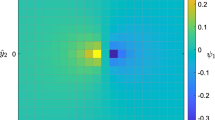Abstract
The system of differential equations proposed by V. Volterra, desoribing the variation in time of the populationsN r of interacting species in a biological association, admits a Liouville's theorem (when logN r are used as variables) and a universal integral of “motion”. Gibbs' microcanonical and canonical ensembles can then provide a thermodynamic description of the association in the large. The “temperature” measures in one number common to all species the mean-square deviations of theN r from their average values. There are several equipartition theorems, susceptible of direct experimental test, a theorem on the flow of “heat” (the conserved quantity in an isolated association) between two weakly coupled associations at different temperatures, a Dulong-Petit law for the heat capacity, and an analog of the second law of thermodynamics expressing the tendency of an association to decline into an equilibrium state of maximal entropy. The analog of the Maxwell-Boltzmann law is a distribution of intrinsic abundance for each species which has been successfully used by ecologists for interpreting experimental data. A true thermodynamics develops upon introducing the idea of work done on an association through a variation of the variables (such as physical temperature) defining the physical and chemical environment. An ergodic theorem is suggested by the agreement of ensemble and time averages in the one case where the latter may be found explicitly.
Similar content being viewed by others
Literature
Chandrasekhar, S. 1943. “Stochastic Problems in Physics and Astronomy.”Rev. Mod. Phy.,15, 1–89.
Corbet, A. S., Fisher, R. A., and Williams, C. B. 1943. “The Relation between the Number of Species and the Number of Individuals in a Random Sample of an Animal Population.”J. Anim. Ecol.,12, 42–58.
Gibbs, J. W. 1902.Elementary Principles in Statistical Mechanics. New Haven: Yale University Press.
Grad, H. 1952. “Statistical Mechanics of Dynamical Systems with Integrals other than Energy.”J. Phys. Chem.,56, 1039–1048.
Kendall, D. G. 1948. “On Some Modes of Population Growth Leading to R. A. Fisher's Logarithmic Series Distribution”Biometrika,35, 6–15.
Khinchin, A. I. 1949.Mathematical Foundations of Statistical Mechananics. New York: Dover Publications.
Lotka, A. J. 1925.Elements of Physical Biology. Baltimore: Williams and Wilkins Co..
Schrödinger, E. 1952.Statistical Thermodynamics. Cambridge: University Press.
Takenake, S. 1941. “Über die Volterrasche Biologische Dynamik.”Jap. Jour. Med. Sci., Part, iii, Biophysics,7, 129–140.
ter Haar, D. 1954.Elements of Statistical Mechanics, New York: Rinehart and Co..
— 1955. “Foundations of Statistical Mechanics.”Rev. Mod. Phys.,27, 289–338.
Tolman, R. C. 1938.The Principles of Statistical Mechanics. Oxford: Clarendon Press.
Volterra, V. 1931.Leçons sur la Théorie Mathématique de la Lutte pour la Vie. Paris: Gauthier-Villars.
— 1937. “Principes, de Biologie Mathématique.”Acta Biotheoretica,3, 1–36.
Author information
Authors and Affiliations
Rights and permissions
About this article
Cite this article
Kerner, E.H. A statistical mechanics of interacting biological species. Bulletin of Mathematical Biophysics 19, 121–146 (1957). https://doi.org/10.1007/BF02477883
Received:
Issue Date:
DOI: https://doi.org/10.1007/BF02477883




